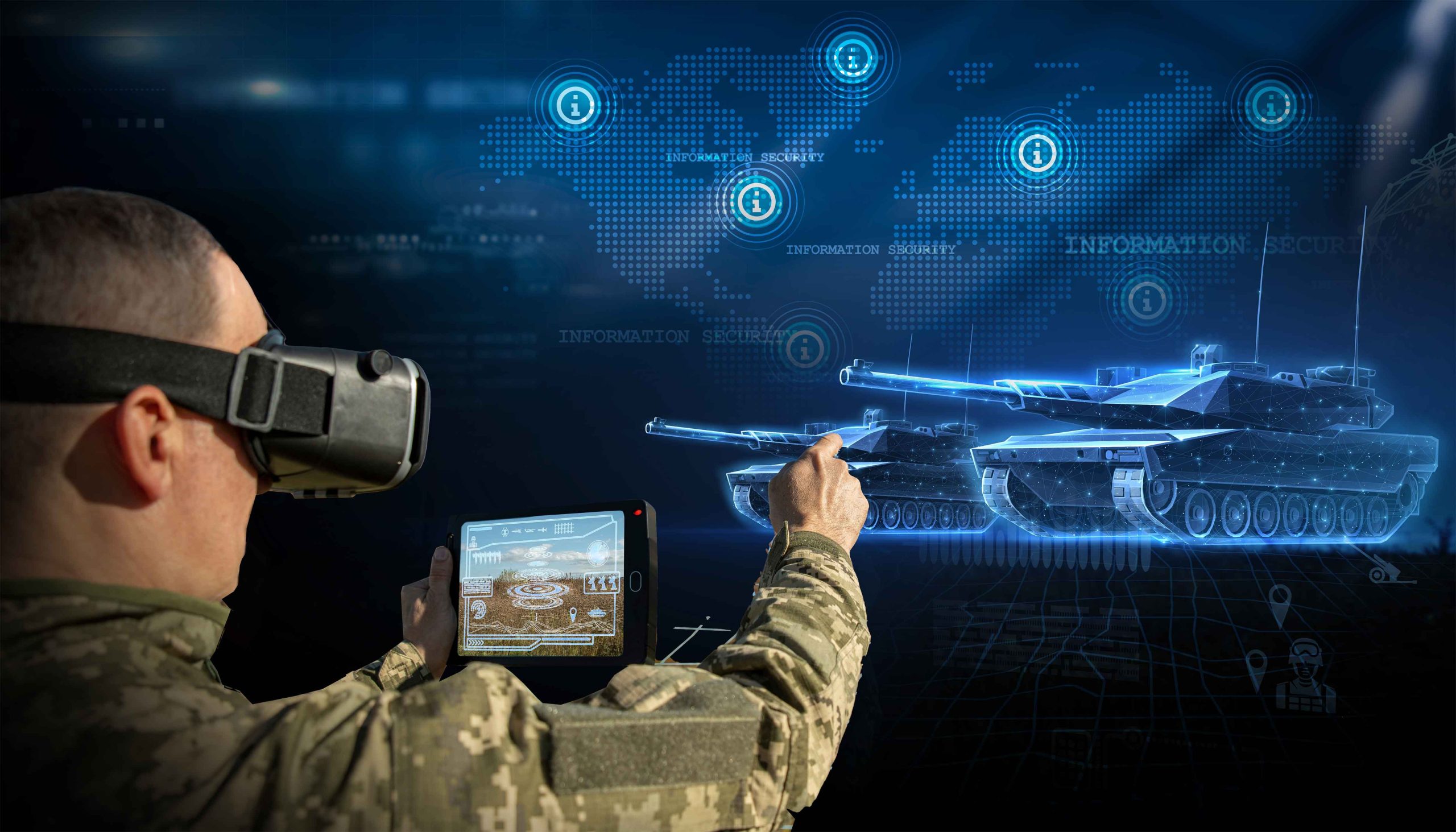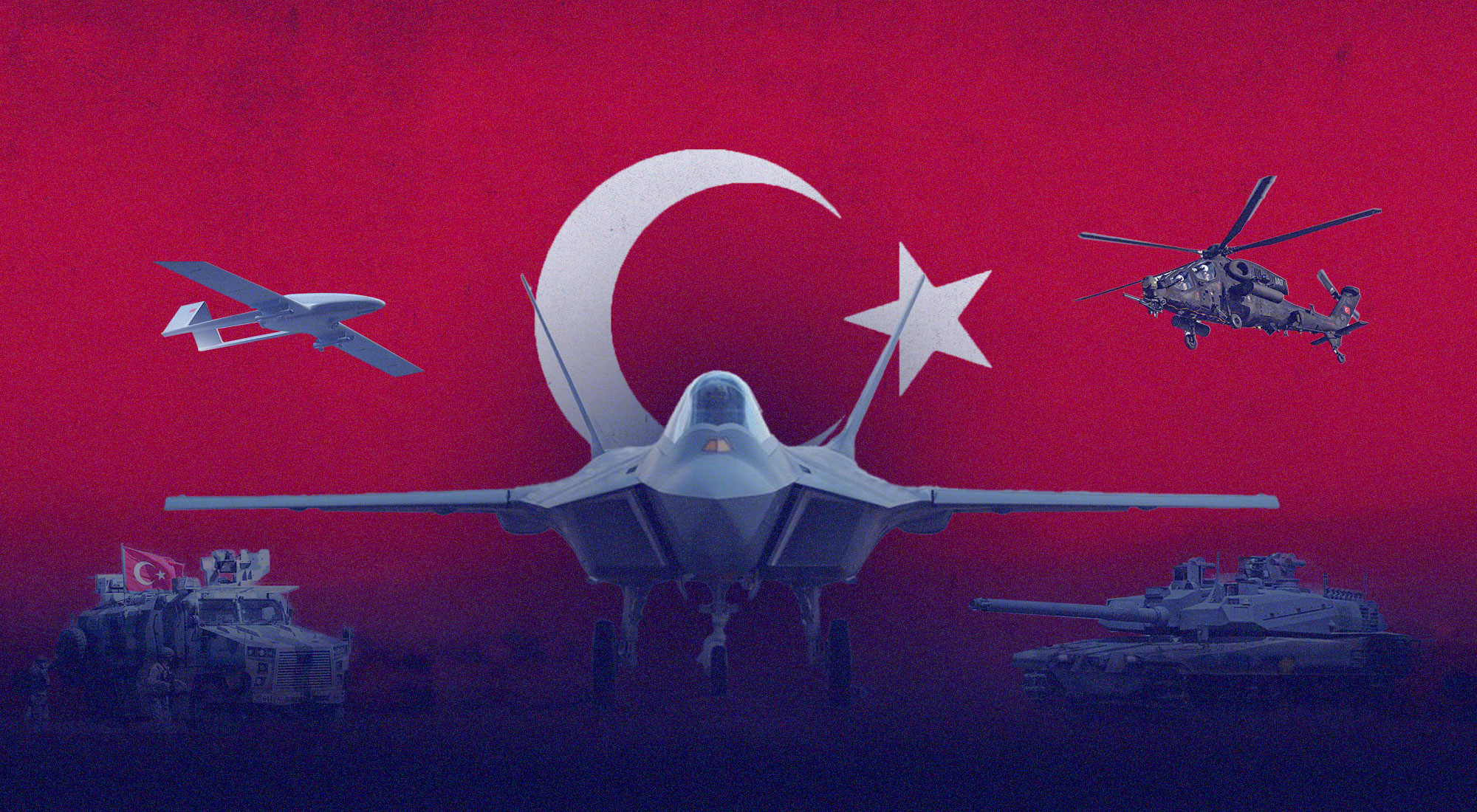
(U.S. Dept of Defense/Peggy Frierson)
With the rising international tensions, from the Middle East to the Pacific, and the expansion of current conflicts across the globe, such as the Russia-Ukraine war, we are witnessing an escalation unprecedented in recent history.[1] The implications of such tensions span not only geographically but also, with the rapid technological developments of recent years, into the domains of space and cyberspace. AI has recently become a central aspect in the development of the future of warfare and the defense sector as a whole. For example, the French Navy announced plans to turn to AI for signals analysis in underwater acoustics warfare.[2] Similarly, the Italian defense giant Leonardo, in a presentation to analysts a few weeks ago, predicted its defense-related cybersecurity, space, and AI work would rise fourfold by 2028.[3] This clearly shows a trend where AI is increasingly becoming quintessential to the concept of war and the defense sector as a whole. This means that understanding AI is becoming crucial to defining the future of both the defense sector and warfare. As discussed in my recent insight, “AI Pollution: The Future Threats of Information Warfare,” the increasingly pervasive integration of AI into various processes has gone well beyond mere cyberspace.[4] We must understand the integration and impact of AI beyond what has been understood until now. In this context, AI is driving a progressive blending of security dimensions.
The premise of this paper is to build on the points made in my last paper on AI Pollution, analyzing how AI is currently impacting the defense sector and global security, and envisioning the potential developments it could cause. For instance, an analysis of current military doctrines, structures, and approaches reveals gaps that AI has the potential to fill while at the same time creating new vulnerabilities. Based on the findings of my latest insight, we can understand the potential reshaping of military dynamics and, consequently, the potential alteration of the strength and power projection of countries. The objective is to examine how AI, as a new agent, will influence the concept of the Regional Security Complex. This could lead to a complete shift in conflicts, such as those between China and the U.S. over control of the Pacific or among various regional actors in the Middle East. This study aims not only to envision and analyze how AI is transforming weaponry and the efficiency of current armament systems but also to understand how AI is fundamentally redefining the paradigm of security and altering the understanding of warfare and security. This is crucial not only from an academic standpoint but also for governments and defense agencies, as the ability to redefine their defense policies to adapt to these fundamental changes will be a critical advantage in shaping the future security landscape of the upcoming century. This paper aims to provide the reader with a holistic understanding of potential developments, starting from a technical analysis of current events and trends, to then define the potential role and impact that AI could have on the defense sector and, in turn, global security.
The main question this paper addresses is how AI has affected and will affect security and geopolitics based on the Regional Security Complex Theory (RSCT) developed by the Copenhagen School of International Security Studies. This theory emphasizes that geopolitical dynamics at the regional level should be seen as interdependent and functioning like regional clusters, driven mainly by geographic proximity. Security is viewed as a socially constructed concept shaped by the perceptions, interests, and interactions of actors in each region.[5] This is closely related to constructivism, which emphasizes the importance of social constructions and ideational factors in shaping the behavior and interactions of states and other actors in the international system.[6] The interactions among states in the regional security complex create an interdependence of security within a geographically coherent grouping. This paper will also reference a modified version of the Regional Security Complex Theory called the “securitization model,” which helps understand the complex web of connections between affected countries and how events impact those connections. Overall, this paper will emphasize the importance of understanding how AI, through macroscopic changes in technology, procedures, and doctrine, affects wider macroscopic regional dynamics.
This paper proposes a new understanding of AI as an integrator of the Domains of Warfare stemming from the Domain of Cyberspace. In this expansive progression, AI is increasingly interacting with the human element, causing the phenomenon of AI Pollution to become an increasingly relevant security threat.[7] The conclusion is that the lack of a holistic approach, which aims at the balanced integration of military doctrine and human dynamics that differ from country to country, and AI logic that differs from model to model, plays a major role in the increasing lack of flexibility in military operations. This, in turn, increases the vulnerabilities of military processes and affects defense and power projection capabilities. Therefore, it is imperative to develop strategies that account for the intricate dynamics introduced by AI to maintain robust and adaptive military and defense structures. Understanding and implementing such an integrated approach will be vital for future military effectiveness and national security.
AI Permeation: Accelerating the Integration of the Domains of Warfare
In order to understand the relationship between AI and the defense sector, we first need to comprehend and define the concept of “domains of warfare.”[8] This concept refers to the distinct environments in which military operations are conducted. These domains encompass the various physical and virtual spaces where armed forces engage in conflict to achieve their strategic objectives. The primary domains include Land, Sea, Air, Space, and Cyber, each possessing unique characteristics and requiring specialized tactics, technologies, and strategies.
Firstly, the Land Domain is characterized by a highly kinetic type of warfare, where opposing forces engage in combat to control land and population centers. This domain involves direct physical confrontation and the deployment of ground troops, tanks, and artillery to secure strategic locations and influence the outcome of conflicts. The Sea Domain, on the other hand, is central to a country’s power projection capabilities. This is exemplified by the use of aircraft carriers and naval fleets to conduct prolonged operations far from home territories or to assert control over territorial waters. Sea power is crucial for maintaining global presence, ensuring maritime security, and supporting amphibious operations. The Air Domain is defined by its extreme mobility and the objective of achieving air dominance over adversaries. Control of the skies allows for strategic superiority, enabling aerial reconnaissance, precision strikes, and rapid troop deployment. Air power is vital for both offensive and defensive operations, impacting the overall effectiveness of military campaigns. The Space Domain, though the newest, is becoming increasingly crucial. It encompasses the control of satellites and space-based infrastructure, which are essential for telecommunications, navigation, and strategic awareness. Dominance in space provides significant advantages in intelligence gathering, missile defense, and the coordination of military operations across other domains. Lastly, the Cyber Domain is transversal to all the previously mentioned domains. It is the least kinetic, yet it has the most far-reaching effects. Cyberwarfare involves the manipulation and disruption of information systems, networks, and data. It is the medium through which much of society interacts and operates, making it a critical area for both defensive and offensive operations. The cyber domain affects every aspect of modern warfare, from communication to command and control systems, making it indispensable in contemporary military strategy.[9]
Understanding these domains helps outline the importance and potential role of each in relation to the Regional Security Complex Theory (RSCT). RSCT provides a framework for analyzing how regional security dynamics are influenced by the interaction of these domains.[10] For instance, control of the Sea and Air domains can significantly impact regional power balances and influence geopolitical stability. Similarly, dominance in the Cyber and Space domains can alter strategic dynamics by affecting communication and information superiority.[11] By integrating AI into these domains, we can further enhance military capabilities and effectiveness. AI can improve decision-making, optimize resource allocation, and enable more precise and efficient operations across all domains. However, it also introduces new vulnerabilities and challenges, necessitating a thorough understanding of both the technological and human factors involved.
In summary, the concept of domains of warfare is fundamental to understanding the relationship between AI and the defense sector. Each domain presents unique challenges and opportunities, and their integration with AI has the potential to transform modern military operations. As we continue to explore this relationship, it is essential to consider the strategic implications and the evolving nature of warfare in the context of regional and global security.[12]

Source: GAO-19-570, GAO analysis of Department of Defense information
Now that we have explained each of these domains, we can begin analyzing the relationship of AI with them. Firstly, it is essential to understand that AI is intrinsically connected to cyberspace, where it exists as an entity. However, as previously explained, its reach extends well beyond this dimension. This is because AI is not confined to being a space where information is merely transferred or manipulated. Instead, it acts as an active agent capable of responding to inputs, evolving, and interacting with external forces beyond those found in cyberspace. Consequently, stemming from the cyber domain, AI is increasingly expanding its influence into the other domains of warfare. It is becoming an element that must be considered in strategic decision-making, not only related to cyberwarfare but also, for example, by soldiers operating on the ground. This expanding influence necessitates a broader understanding and integration of AI in various military strategies and operations.[13]

Source: Edwin Lax, TRENDS Research & Advisory
For example, the integration of AI into weapon and recognition systems could mean that commanders will need to find new ways to camouflage and deploy troops. Additionally, the way military organizations and procedures currently operate could be redefined to improve their operational efficiency by integrating AI into their processes, requiring a different employment of manpower. From this macroscopic perspective, we can observe the transversal and increasingly pervasive reach of AI. This development means that these different domains of warfare are becoming more interconnected than ever, with AI serving as the common denominator among them all.[14]
AI Beyond Weapon Systems: Redefining the Paradigm of War
Starting from the points made previously, we can see how the increasing push towards AI in defense technology is far more profound, potentially leading to a radical change in the dynamics of war stemming from technological advancements and translating into broader strategic implications.
It is important to understand, however, that these changes will not solely be the result of AI itself but also of its interaction with the human factor. The effectiveness of a military does not merely lie in its weaponry but also in its organization, bureaucratic system, and doctrine—in essence, the way the military operates and perceives its mission.
These elements vary from one organization to another and between countries. For example, in my experience with both European militaries and the U.S. military, I have observed several differences in their approaches to these domains of warfare, which, in turn, influence the outcome of AI integration into their processes. The approach of European militaries is generally characterized by a more holistic and individual-centric methodology, which enhances resilience to unexpected events and fosters the development of improvised and creative solutions. However, this comes at the cost of specialized, highly efficient military processes. On the other hand, the U.S. military relies heavily on defined and specialized approaches that are continuously optimized. This reliance, however, often results in challenges in integrating these specializations into a cohesive, holistic vision and greater difficulty in responding to unanticipated events that were not accounted for by the optimized processes.
From this, we can see how the integration of AI could differ significantly, not only due to technical variations but also because of the culture, structure, and general approach of each military and country to it. This leads to a new perspective, where the impact of AI in defense will be shaped not only by technological advancements but also by human elements that military leadership has historically underestimated.[15]
For this reason, I believe it is crucial to rethink and update the concept of the domains of warfare by incorporating the human/policy domain as an essentially transversal element that AI has made relevant to the idea of defense policy. This change implies the creation of new dynamics between an organization and AI, as well as the emergence of new vulnerabilities.[16] For example, AI that operates automated military processes could be exploited to condition the humans and military structures that depend on it, reducing efficiency or causing impairment. In the case of the U.S. military, this could lead to increased unpredictability by exploiting its highly policy-reliant approach. Conversely, in most European militaries, AI could exploit the individual-centric approach by manipulating emotions, causing individuals to make inefficient or self-sabotaging decisions.[17]
These significant vulnerabilities arise from the growing interaction between humans and AI, potentially transforming AI into the most dangerous insider threat. This is a vulnerability that must be considered when envisioning the core of a military organization and the future of defense policy. It is essential not only to react to these future scenarios but also to proactively redefine the vision of what defense entails. By acknowledging and addressing these complexities, we can better prepare for the integration of AI in defense, ensuring that both technological and human factors are harmoniously balanced for optimal outcomes.[18]
Leveling the Playfield: How AI is Redefining Power Dynamics
Now that we have explored the impact of AI on a microscopic level and examined its relationship with military organizations and humans, we will zoom out to understand the broader implications and overall effects of integrating AI on the power dynamics between different militaries. As I discussed in my recent insight on AI pollution, AI should be seen as an accelerator and amplifier of existing dynamics.[19] This means that AI not only enhances the efficiency and processes of large, well-established militaries but also expands the capabilities of smaller militaries. By leveraging AI, smaller militaries can gain a foothold in cyberspace, compensating for their lack of a powerful arsenal and limited manpower by expanding their cyber reach and capabilities. This also presents opportunities to exploit the reliance of larger militaries on AI, potentially using it against them. Paradoxically, smaller militaries may have a greater ability to recognize and respond to AI pollution and the insider threats posed by AI.[20]
This heightened sensitivity in smaller militaries arises because their processes and organizational structures are more sensitive to internal changes. In environments where interpersonal relationships between members are critical, it becomes easier to detect variations in behavior or bureaucratic processes. Consequently, smaller militaries are generally more resistant to AI pollution. In contrast, larger militaries, which rely heavily on predefined organizational processes, are more vulnerable to AI pollution. Their dependence on the outcomes of these processes often blinds them compared to the interpersonal dynamics that could indicate adversarial exploitation of AI. Thus, the uncritical consensus and reliance on standardized procedures, exacerbated by the size of a military, emerge as significant vulnerabilities in modern militaries that are increasingly integrating AI into their weapon systems and bureaucratic procedures. This suggests that AI vulnerabilities are inherently greater in larger military organizations, while they are somewhat mitigated in smaller ones.[21]
This shift results in a partial leveling of the security playing field. Smaller militaries, which traditionally lacked the capabilities to challenge larger ones, can now leverage AI to conduct more sophisticated cyberattacks and corrupt the internal AI-reliant processes of their larger rivals. This can hinder decision-making and operational efficiency, which are crucial for the functioning of a modern military.
The “corruption” or pollution of AI is particularly concerning at the moment. The window of opportunity for exploiting AI is influenced not only by the technical limitations of the AI program but also by its relationship with the user and the process, as explained earlier. Different militaries have different approaches, meaning that AI can be trained not only to attack the program directly through false information but also to exploit vulnerabilities in how the organization operates the AI and implements its processes.[22]
Consider, for example, the recent implementation of AI overviews by Google Search. This feature provides brief answers to questions typed into Google, relying on results found on the internet. Such applications of AI are vulnerable to AI pollution because their dependence on online information makes them easily exploitable through the dissemination of false information, thereby altering search results.[23] The depth of influence that these AI overviews have on the final user is also affected by how the user interacts with the feature. Do they verify the information? Do they implement the answer in a particular way to solve their problem? Further study and analysis of these interactions could open a new frontier in cyber warfare, emphasizing psychological and indirect internal disruption over direct attacks such as DDoS, or the AI software itself.[24] This scenario is becoming increasingly real, exemplified by the recent integration of NIPR-GPT by the U.S. Department of the Air Force. Although this new AI model is still in its initial stage, it strongly signals and anticipates the pervasive role that AI will play in military processes.[25]
For these reasons, it is crucial that we develop a new concept of cybersecurity and re-evaluate how different militaries interact with each other in the context of warfare.
Reshaping the Paradigm of Global Security
By zooming out further, we notice how the most basic alterations of internal processes in military organizations can significantly influence more macroscopic strategic dynamics. Specifically, the reshaping of the concept of security and cyberwarfare due to the implementation of AI has profound impacts on greater geopolitical dynamics between countries and the ways they pursue their strategic objectives.[26] For example, the use of AI to support the planning and implementation of logistical lines, scheduling deployment cycles, and determining flight hours for pilots could greatly enhance the operational capabilities of the U.S. military in the Middle East. However, an overreliance on AI in these processes, combined with a policy-centric approach, could be exploited by Iran’s proxies. These proxies could manipulate and twist AI capabilities through direct cyberattacks, which could become much more effective and amplified by their own reliance on AI, and through AI pollution, corrupting the ground data that AI uses, such as satellite topographical data and on-the-ground intelligence and online open-source intelligence.[27]
These proxies, for instance, could attack satellite networks aided by AI to alter topographical reports, use AI to psychologically influence local populations, and disseminate false online data. This compromised intelligence, once utilized by AI, could generate logistical routes where military assets might be involuntarily exposed to direct attacks by smaller forces, thereby potentially disrupting American military logistics in the region.[28] Indirectly, this could put more strain on logistical lines than necessary, thus potentially weakening American military capabilities in the region. Additionally, since American military personnel are generally more reliant on efficient policies and predefined processes compared to their European peers, there could be a potential lack of awareness in sensing alterations and disruptions in AI output.[29]
Furthermore, the integration of AI into military operations also brings about changes in how strategic decisions are made and executed. AI systems, by their nature, operate based on data inputs and programmed algorithms, which means that any corruption or manipulation of data can lead to significant errors in strategic planning and execution. This could have cascading effects, leading to miscalculations in troop movements, supply chain management, and even the timing of critical operations. Such vulnerabilities highlight the need for robust cybersecurity measures and the development of AI systems that are resilient to both external attacks and internal errors.[30]
This situation could mean that Iran’s proxies, although smaller and less equipped, could potentially expand their capabilities, disrupt or impact air supplies to American military bases in the Gulf, alter drone routes and strike capabilities, and afford Iran the ability to temporarily elude Western military capabilities, striking well beyond what is currently thought possible. This represents an immense strategic risk that military leadership needs to address through a renewed understanding of strategic dynamics and a different approach to military processes and cybersecurity.[31]
Moreover, the geopolitical implications of AI in military operations extend beyond immediate tactical concerns. The implementation of AI in defense strategies can influence international relations, as countries may view AI-enhanced capabilities as a threat or an opportunity, depending on their own military capabilities and employment of military assets. The competitive nature of AI development in the military sector could lead to an escalation of security dynamics where nations and local actors continuously strive to outdo each other in AI capabilities, further complicating global security dynamics. This further enhances the importance of international cooperation and dialogue to manage the risks associated with AI in military contexts and to establish norms and regulations that can prevent escalations and promote stability.[32]
In conclusion, while AI offers significant potential to enhance military capabilities, it also introduces new vulnerabilities and strategic risks that must be carefully managed. Military leadership must not only focus on integrating AI effectively into their operations but also on developing comprehensive strategies to mitigate the associated risks. This involves investing in cybersecurity, fostering a culture of vigilance and less reliance on predefined processes among personnel, and engaging in international efforts to regulate and manage the use of AI in military contexts. Only through such a multifaceted approach can the full benefits of AI be realized while minimizing the potential risks of a military escalation.[33]
Conclusions
As we have seen, the progressive implementation of AI in the defense sector and modern militaries is opening up Pandora’s box. The unpredictable nature of this new technology is caused by its rapid development, adaptive nature, and a partial understanding of the effects of its application. What is progressively emerging, though, are the variables that will determine the extent and type of effects it will have on warfare dynamics and the agencies that will implement it. Along with this, we can see how this radical change will necessitate a new understanding of geopolitical dynamics, cybersecurity, and military doctrine, which can better incorporate the changes brought by AI.[34]
Furthermore, the integration of AI systems is not just a technical or operational shift; it represents a fundamental transformation in military strategy and policy. The deployment of AI will require comprehensive training programs for personnel as well as significant adjustments in command-and-control structures to fully harness the technology’s potential. Moreover, ethical considerations will become increasingly critical, as the use of AI in combat scenarios raises questions about accountability, decision-making, and the potential for unintended consequences through AI pollution.[35]
Finally, the integration of AI systems will bring about a change in the balance of power between countries and militaries, which will redefine the different regional security complexes and the concept of security in the near future, as we have seen in the hypothetical scenario of an attack on the U.S. military capabilities in the GCC. This shift will likely lead to new alliances and rivalries as different groups will seek to either adopt or counteract AI capabilities. In this evolving landscape, maintaining a strategic edge will be paramount, necessitating continuous innovation and adaptation to the rapidly changing technological development of AI.
[1] Elliott Abrams, “Implications of the Russia-Ukraine War,” Council on Foreign Relations, February 26, 2023, https://www.cfr.org/blog/implications-russia-ukraine-war (accessed May 26, 2024).
[2] Rudy Ruitenberg, “France Turns to AI for Signals Analysis in Underwater Acoustics War,” Defense News, May 17, 2024, https://www.defensenews.com/global/europe/2024/05/17/france-turns-to-ai-for-signals-analysis-in-underwater-acoustics-war/ (accessed May 26, 2024).
[3] Vivienne Machi, “Leonardo Banks on Space, Cybersecurity, AI for Double-Digit Growth,” Defense News, March 12, 2024, https://www.defensenews.com/global/europe/2024/03/12/leonardo-banks-on-space-cybersecurity-ai-for-double-digit-growth/ (accessed May 27, 2024).
[4] Edwin Lax, “AI Pollution: The Future Threats of Information Warfare,” Trends Research & Advisory, May 17, 2024, https://trendsresearch.org/insight/ai-pollution-the-future-threats-of-information-warfare/ (accessed May 27, 2024).
[5] Buzan Barry, Ole Wæver, and Jaap de Wilde, Security: A New Framework for Analysis (Boulder: Lynne Rienner Publishers, 1997).
[6] Michael C. Williams, “Words, Images, Enemies: Securitization and International Politics,” International Studies Quarterly 47, no. 4 (2003): p. 511, https://www.jstor.org/stable/3693634.
[7] Edwin Lax, “AI Pollution: The Future Threats of Information Warfare,” Trends Research & Advisory, May 17, 2024, https://trendsresearch.org/insight/ai-pollution-the-future-threats-of-information-warfare/ (accessed May 28, 2024).
[8] Gen. Ronald R. Fogleman, “Information Operations: The Fifth Dimension of Warfare,” remarks delivered to the Armed Forces Communications-Electronics Association, Washington, April 25, 1995, published in Volume 10, Number 47, archived from the original on February 20, 2020, https://web.archive.org/web/20200220002026/http://www.iwar.org.uk/iwar/resources/5th-dimension/iw.htm (accessed May 28, 2024).
[9]Jeff D. Dailey, Fifth Dimensional Operations (Small Wars Journal, 2014), 64-70. https://smallwarsjournal.com/jrnl/art/fifth-dimensional-operations.
[10] Buzan Barry, Ole Wæver, and Jaap de Wilde, Security: A New Framework for Analysis (Boulder: Lynne Rienner Publishers, 1997).
[11] Col. Timothy Murphy, “The Strategy Web: A New Framework for Analyzing Military Strategy,” Air University: Wild Blue Yonder, March 27, 2020, https://www.airuniversity.af.edu/Wild-Blue-Yonder/Article-Display/Article/2127317/the-strategy-web-a-new-framework-for-analyzing-military-strategy/. (Accessed May 28, 2024)
[12] James Jay Carafano, America’s Joint Force and the Domains of Warfare in 2018 Index of U.S. Military Strength (The Heritage Foundation, 2018), https://acrobat.adobe.com/id/urn:aaid:sc:VA6C2:2d6cb846-8e76-4215-a5dc-217c9f9d97de.
[13] Chen, Annie, Military Applications of Artificial Intelligence: Ethical Concerns in an Uncertain World (RAND Corporation 2020), https://www.rand.org/pubs/research_reports/RR3139-1.html.
[14] Walter David, Paolo Pappalepore, Alexandra Stefanova & Brindusa Andreea Sarbu, AI-Powered Lethal Autonomous Weapon Systems in Defence Transformation: Impact and Challenges,” MESAS: International Conference on Modelling and Simulation for Autonomous System, March 30, 2020 https://link.springer.com/chapter/10.1007/978-3-030-43890-6_27 (accessed May 29, 2024)
[15] Col. Joshua Glonek, “The Coming Military AI Revolution.” Military Review Journal, (May-June 2024): https://www.armyupress.army.mil/Journals/Military-Review/English-Edition-Archives/May-June-2024/MJ-24-Glonek/
[16] Amir Husain. “AI is Shaping the Future of War,” National Defense University Press, November, 2021, https://ndupress.ndu.edu/Portals/68/Documents/prism/prism_9-3/prism_9-3_50-61_Husain.pdf (accessed June 1, 2024)
[17] Mathieu P. Amirault, “Military Thought and Doctrine in Europe and the United States: Patterns of Interaction in the Twentieth Century” (Master’s thesis, Naval Postgraduate School, 2021), https://apps.dtic.mil/sti/citations/trecms/AD1150782.
[18]Nick Starck, David Bierbrauer and Paul Maxwell, “ARTIFICIAL INTELLIGENCE, REAL RISKS: UNDERSTANDING—AND MITIGATING—VULNERABILITIES IN THE MILITARY USE OF AI,” Modern War Institute, January 18, 2022, https://mwi.westpoint.edu/artificial-intelligence-real-risks-understanding-and-mitigating-vulnerabilities-in-the-military-use-of-ai/ (accessed June 18, 2024)
[19]Barry Pavel, Ivana Ke, Michael Spirtas, James Ryseff, Lea Sabbag, Gregory Smith, Keller Scholl, Domenique Lumpkin, “AI and Geopolitics: How might AI affect the rise and fall of nations?,” RAND Corporation, November 3, 2023 https://www.rand.org/pubs/perspectives/PEA3034-1.html (Accessed June 5, 2024)
[20] Araya, Daniel, and Meg King. “The Impact of Artificial Intelligence on Military Defence and Security,” Centre for International Governance Innovation, March, 2022 https://www.cigionline.org/static/documents/no.263.pdf (accessed June 6, 2024)
[21]“The Cybersecurity Vulnerabilities to Artificial Intelligence,” Council on Foreign Relations, August 28, 2017 https://www.cfr.org/blog/cybersecurity-vulnerabilities-artificial-intelligence (accessed June 6, 2024)
[22] Edwin Lax, “AI Pollution: The Future Threats of Information Warfare,” Trends Research & Advisory, May 17, 2024, https://trendsresearch.org/insight/ai-pollution-the-future-threats-of-information-warfare/ (accessed May 28, 2024).
[23] Williams, Rhiannon. “Why Google’s AI Overviews Gets Things Wrong,” MIT Technology Review, May 31, 2024 https://www.technologyreview.com/2024/05/31/1093019/why-are-googles-ai-overviews-results-so-bad/ (accessed June 6, 2024)
[24] Edwin Lax, “AI Pollution: The Future Threats of Information Warfare,” Trends Research & Advisory, May 17, 2024, https://trendsresearch.org/insight/ai-pollution-the-future-threats-of-information-warfare/ (accessed May 28, 2024).
[25] Secretary of the Air Force Public Affairs, “Department of the Air Force Launches NIPR GPT,” U.S. Air Force, June 10, 2024 https://www.af.mil/News/Article-Display/Article/3800809/department-of-the-air-force-launches-niprgpt/ (accessed June 12, 2024)
[26] Bassant Hassib, Fatimah Ayad, The Challenges and Implications of Military Cyber and AI Capabilities in the Middle East: The Geopolitical, Ethical, and Technological Dimensions.” (Springer Press, 2023),49-65. https://link.springer.com/chapter/10.1007/978-3-031-32432-1_4
[27] O’Hanlon, Michael E. “The Role of AI in Future Warfare,” Brookings Institution, November 29, 2018 https://www.brookings.edu/articles/ai-and-future-warfare/ (accessed June 12, 2024)
[28] Jason Wolff, “The Department of Defense’s Digital Logistics Are Under Attack,” Brookings Institution, July, 2023 https://www.brookings.edu/articles/the-department-of-defenses-digital-logistics-are-under-attack/ (accessed June 12, 2024)
[29] Geist, Edward, Andrew J. Lohn, “How Might Artificial Intelligence Affect the Risk of Nuclear War,” RAND Corporation, 2018 https://www.rand.org/content/dam/rand/pubs/perspectives/PE200/PE296/RAND_PE296.pdf (accessed June 12, 2024)
[30] Wojciech Horyń, Marcin Bielewicz & Adam Joks, AI-Supported Decision-Making Process in Multidomain Military Operations (Springer, 2021), 93-107. https://link.springer.com/chapter/10.1007/978-3-030-88972-2_7
[31] Seth G. Jones, “War by Proxy: Iran’s Growing Footprint in the Middle East,” Center for Strategic and International Studies (CSIS), March 11, 2019 https://www.csis.org/analysis/war-proxy-irans-growing-footprint-middle-east (accessed June 12, 2024)
[32] Jonas Tallberg, Eva Erman, Markus Furendal, Johannes Geith, Mark Klamberg, Magnus Lundgren, “Global Governance of Artificial Intelligence: Next Steps,” Oxford Academic 25, no. 3 (September 2023): https://academic.oup.com/isr/article/25/3/viad040/7259354
[33] Nick Starck, David Bierbrauer and Paul Maxwell, “ARTIFICIAL INTELLIGENCE, REAL RISKS: UNDERSTANDING—AND MITIGATING—VULNERABILITIES IN THE MILITARY USE OF AI,” Modern War Institute, January 18, 2022, https://mwi.westpoint.edu/artificial-intelligence-real-risks-understanding-and-mitigating-vulnerabilities-in-the-military-use-of-ai/ (accessed June 18, 2024)
[34] Vincent Boulanin, “The Impact of Artificial Intelligence on Strategic Stability and Nuclear Risk,” STOCKHOLM INTERNATIONAL PEACE RESEARCH INSTITUTE, no. 1 (November 2019): https://www.sipri.org/publications/2019/research-reports/impact-artificial-intelligence-strategic-stability-and-nuclear-risk-volume-i-euro-atlantic
[35] Maj. Robert A. Coombs, “AI Integration for Scenario Development: Training the Whole-of-Force,”Military Review, May, 2023, https://www.armyupress.army.mil/Journals/Military-Review/Online-Exclusive/2024-OLE/AI-Integration-for-Scenario-Development/ (accessed June 15, 2024)








